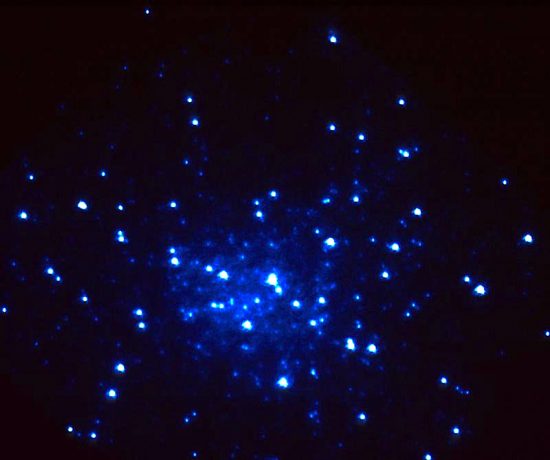
Oct 30, 2019
Astronomers think that light from remote globular clusters should be blue.
“Blue oblivion, largely lit, smiled and smiled at me.”
—William Rose Benet
Modern astronomers measure the Universe with a tool based on a theory of its expansion. They believe that objects farther out into space are representative of the Universe as it was closer to its beginning, so galaxies located at 1.2 billion light years are supposed to be as they were 1.2 billion years ago. Stars that are observed at that distance, therefore, should be youthful, with rich supplies of hydrogen fuel. They ought to be hot and blue, radiating high frequency X-rays and extreme ultraviolet light.
According to a research team using the Hubble Space Telescope, there are clusters of stars orbiting another galaxy over a billion light years away that aren’t behaving “correctly”: rather than being blue-white they are red.
Globular clusters are normally found in a halo around galactic nuclei. They are thought to be structures that have been gravitationally attracted to the host galaxy because many of them have the appearance of age—they have large populations of red stars that are supposed to be old. Some theories speculate that the clusters might have been ejected from a host galaxy, or that they formed in conjunction with a host galaxy.
Why is this so? Current models rely on the principles outlined above, so star clusters that are 20% redder than predicted could due to a metal-rich population of globular clusters, or that the stellar models are incorrect. The third possibility is that the theory is simply incomplete and not incorrect.
In a previous Picture of the Day, it was noted that retired Professor of Electrical Engineering, Dr. Donald Scott, in his book The Electric Sky, showed how the Hertzsprung-Russell diagram of stellar evolution can be improved by adding another scale to the horizontal axis: Current Density at the Star’s Surface. The way stars appear is not dependent on age and distance, but on the amount of energy flowing into them from their surroundings. The greater the electric current, the hotter and brighter the star should appear.
Consensus theories state that as stars accumulate heavier elements in their cores, they fluctuate in output because their temperatures change with changes in fusion reactions. They turn red as one phase ends, and then they turn yellow or white as other elements start to fuse into still heavier atoms. However, as the Hubble team said: “It’s possible there’s something about stellar evolution we don’t understand.” The irony in that statement speaks for itself.
The best conventional explanation that has been forthcoming, at this point, is that there is some intervening cloud of material that acts like a filter, absorbing blue light. Since the star clusters they found are located at such a distance, and they are so faint to begin with, the bluer stars could be hidden behind the clouds.
As Dr. Scott wrote:
“In the Electric Star model, perhaps the most important factor in determining any given star’s characteristics is the strength of the current density in Amperes per square meter (A/m^2) measured at that star’s surface. If a star’s incoming current density increases, the arc discharges on its surface (photospheric tufts) will get hotter, change color (away from red, toward blue), and get brighter. The absolute brightness of a star, therefore, depends on two things: the strength of the current density impinging into its surface, and the star’s size (the star’s diameter).”
So, in reality stars in globular clusters are merely obeying another aspect of cosmic energies that permeate the Universe. It is possible that they are not as far away as they appear. They may not be nearly as old as astronomers believe, because they are not behaving according to gravity and redshift theories but according to theories of plasma cosmology.
Stephen Smith
The Thunderbolts Picture of the Day is generously supported by the Mainwaring Archive Foundation.












